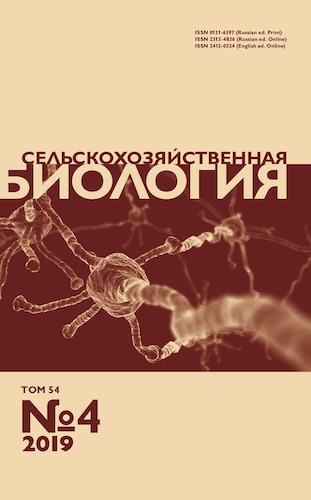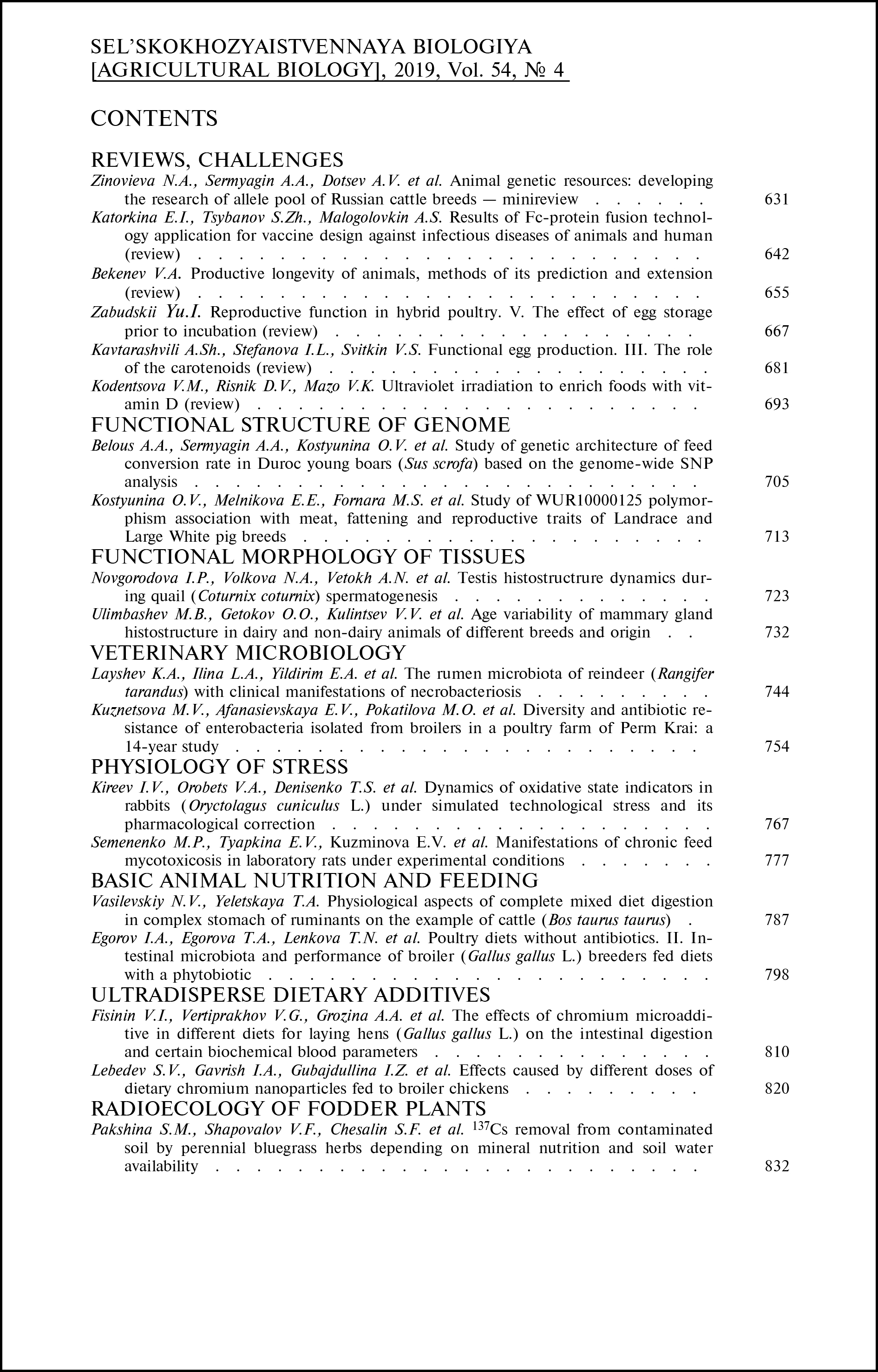doi: 10.15389/agrobiology.2019.4.744eng
UDC: 636.294:579.62:577.2
Acknowledgements:
Supported financially by Russian Science Foundation for project No. 17-76-20026 “Rumen microbiocenosis in Rangifer tarandus of the Russian Arctic as a fundamentals for promising animal biotechnologies”
THE RUMEN MICROBIOTA OF REINDEER (Rangifer tarandus) WITH CLINICAL MANIFESTATIONS OF NECROBACTERIOSIS
K.A. Layshev1, L.A. Ilina2, E.A. Yildirim2, V.A. Philippova2,
T.P. Dunyashev2, A.V. Dubrovin2, D.V. Sobolev2, N.I. Novikova2,
G.Yu. Laptev2, A.A. Yuzhakov1, T.M. Romanenko3, Yu.P. Vylko3
1Northwest Center for Interdisciplinary Research of Food Scurity Problems, 7, sh. Podbel’skogo, St. Petersburg—Pushkin, 196608 Russia, e-mail layshev@mail.ru, alyuzhakov@mail.ru;
2JSC «Biotrof+», 19 korp. 1, Zagrebskii bulv., St. Petersburg, 192284 Russia, e-mail ilina@biotrof.ru (✉ corresponding author), deniz@biotrof.ru, filippova@biotrof.ru, timur@biotrof.ru, dubrowin.a.v@yandex.ru, sdv@biotrof.ru, natalia-iv-nov@rambler.ru, georg-laptev@rambler.ru;
3Laverov Federal Center for Integrated Arctic Research (FCIARctic) RAS, Naryan-Mar Agro-Experimental Station, 1a, ul. Rybnikov, Naryan-Mar, Nenets AO, 166004 Russia, e-mail nmshos@atnet.ru, vylcko.yury@yandex.ru
ORCID:
Laishev K.A. orcid.org/0000-0003-2490-6942
Sobolev D.V. orcid.org/0000-0002-3238-979X
Ilina L.A. orcid.org/0000-0003-2789-4844
Novikova N.I. orcid.org/0000-0002-9647-4184
Yildirim E.A. orcid.org/0000-0002-5846-5105
Laptev G.Yu. orcid.org/0000-0002-8795-6659
Philippova V.A. orcid.org/0000-0001-8789-9837
Yuzhakov A.A. orcid.org/0000-0002-0633-4074
Dunyashev T.P. orcid.org/0000-0002-3918-0948
Romanenko Т.М. orcid.org/0000-0003-0034-7453
Dubrowin A.V. orcid.org/0000-0001-8424-4114
Vylko Yu.P. orcid.org/0000-0002-6168-8262
Received April 28, 2019
Necrobacteriosis is an infectious disease that affects many species of domestic and wild mammals, birds, and humans. The main clinical manifestations of the disease are associated with the development of purulent-necrotic lesions of the skin, mucous membranes, internal organs, and extremities as a result of infection of the host organism by strictly anaerobic pathogenic fuzobacteria, the Fusobacterium necrophorum. For reindeer herding, the problem of necrobacteriosis among other diseases of reindeer is one of the most significant, since it brings the most significant damage to the economic activity of the population of the Russian Arctic. This paper for the first time shows the obtained results on rumen microbiota composition differences between the clinically healthy Rangifer tarandus reindeer of the Russian Arctic and reindeer with necrobacteriosis. The purpose of the study was to characterize the distinctive features of rumen microbiota in the reindeer with the clinical manifestations of necrobacteriosis. The study was carried out on calves (4-6 months) and adults (3-6 years) animals, including clinically healthy individuals and those with necrobacteriosis. Samples of the rumen content were collected during the summer-autumn period in 2017 (n = 3 from each age group) in the Yamalo-Nenets Autonomous District. The total number of bacteria and fungi of the class Neocallimastigales was analyzed by quantitative PCR, the composition of the bacterial community was analyzed by T-RFLP (terminal restriction fragment length polymorphism) method. In individuals with clinical manifestations of necrobacteriosis, a significantly higher content of fusobacteria was detected, 1.79-fold in adults (p < 0.05), and 2.65-fold in calves (p < 0.05). In sick animals of both age groups, there was a significantly higher presence of bacteria of the genus Staphylococus (p < 0.05) and the family Pseudomonadaceae (p < 0.05), some species of which may cause purulent-necrotic lesions of animals. The 4-6 month old calves showed a significant increase (p < 0.05) in the content of family Campylobacteriaceae and family Enterobacteriaceae compared to clinically healthy animals. At the same time healthy individuals showed a greater number of cellulolytic and acid-utilizing bacteria. In general, it was noted that the rumen microbiome of calves with clinical signs of necrobacteriosis is characterized by large changes compared to the adult animals. In particular, in young reindeer with necrobacteriosis, there was a significant increase in the Shannon’s diversity index of the rumen microbial community (p < 0.05), which indicates a greater heterogeneity of the bacterial community compared to healthy individuals. In addition, a significant (p < 0.05) decrease of cellulolytic chytridiomycetes of the class Neocallimastigales was detected in the rumen of this animal group. In this regard, the identified patterns may be due to the physiological features of this stage of animal development in Rangifer tarandus. The obtained results can be a basis for recommendations to improve anti-necrobacteriosis measures in reindeer and to reduce mortality during summer and autumn period.
Keywords: Rangifer tarandus, reindeer, necrobacteriosis, laminitis, Fusobacteriа, T-RFLP analysis, quantitative PCR, rumen microbiome, Russian Arctic.
REFERENCES
- Haigh J., Berezowski J., Woodbury M.R. A cross-sectional study of the causes of morbidity and mortality in farmed white-tailed deer. Can. Vet. J., 2005, 46(6): 507-512.
- Samandas A.M., Laishev K.A. Sibirskii vestnik sel'skokhozyaistvennoi nauki, 2010, 10(214): 48-52 (in Russ.).
- Samolovov A.A. Nekrobakterioz zhivotnykh [Necrobacillosis in animals]. Novosibirsk, 1993 (in Russ.).
- Tadepalli S., Narayanan S.K., Stewart G.C., Chengappa M.M., Nagaraja T.G. Fusobacterium necrophorum: a ruminal bacterium that invades liver to cause abscesses in cattle. Anaerobe, 2009, 15(1-2): 36-43 CrossRef
- Laishev A.Kh., Maslukhina A.G. Trudy NIISKH Krainego Severa, 1966, 13: 37-38 (in Russ.).
- Handeland K., Boye M., Bergsjø B., Bondal H., Isaksen K., Agerholm J.S. Digital necrobacillosis in Norwegian wild tundra reindeer (Rangifer tarandus tarandus). Journal of Comparative Pathology, 2010, 143(1): 29-38 CrossRef
- Nocek J.E. Bovine acidosis: implications on laminitis. J. Dairy Sci., 1997, 80: 1005-1028 CrossRef
- Brooks J.W., Kumar A., Narayanan S., Myers S., Brown K., Nagaraja T.G., Jayarao B.M. Characterization of Fusobacterium isolates from the respiratory tract of white-tailed deer (Odocoileus virginianus). Journal of Veterinary Diagnostic Investigation, 2014, 26(2): 213-220 CrossRef
- Kupca A.M., Rettinger A., Zimmermann P., Hörmansdorfer S., Konrad R., Hafner-Marx A. Severe purulent and necrotizing glossitis in a fallow deer (Dama dama) due to an infection with the involvement of Mannheimia granulomatis. Berl. Munch. Tierarztl. Wochenschr., 2015, 128(7-8): 285-288.
- Zeineldin M., Barakat R., Elolimy A., Salem A.Z.M., Elghandour M.M.Y., Monroy J.C. Synergetic action between the rumen microbiota and bovine health. Microbial Pathogenesis, 2018, 124: 106-115 CrossRef
- Aagnes T.H., Sørmo W., Mathiesen S.D. Ruminal microbial digestion in free-living, in captive lichen-fed, and in starved reindeer (Rangifer tarandus tarandus) in winter. Appl. Environ. Microbiol., 1995, 61(2): 583-591.
- Woodbury M.R., Chirino-Trejo M. Necrobacillosis in white-tailed deer. Proceedings of the 1st World Deer Veterinary Congress and the Deer Branch of the New Zealand Veterinary Association. The Deer Branch New Zealand Veterinary Association, Wellington, 2004: 21-23.
- Haigh J.C., Robert J.H. Farming wapiti and red deer. Mosby, St. Louis, 1993.
- Laptev G.Yu., Novikova N.I., Il'ina L.A., Iyldyrym E.A., Nagornova K.V., Dumova V.A., Soldatova V.V., Bol'shakov V.N., Gorfunkel' E.P., Dubrovina E.G., Sokolova O.N., Nikonov I.N., Lebedev A.A. Normy soderzhaniya mikroflory v rubtse krupnogo rogatogo skota [Standards for cattle rumen microflora abundance]. St. Petersburg, 2016 (in Russ.).
- Maniatis T., Fritsch E.F., Sambrook J. Molecular cloning: A laboratory manual. Cold Spring Harbor, NY, 1982.
- Handeland K., Boye M., Bergsjø B., Bondal H., Isaksen K., Agerholm J.S. Digital necrobacillosis in Norwegian wild tundra reindeer (Rangifer tarandus tarandus). Journal of Comparative Pathology, 2010, 142(1): 29-38 CrossRef
- Smith G.R., Till D., Wallace L.M., Noakes D.E. Enhancement of the infectivity of Fusobacterium necrophorum by other bacteria. Epidemiol. Infect., 1989, 102(3): 447-458.
- Li Y., Hu X., Yang S., Zhou J., Qi L., Sun X., Fan M., Xu S., Cha M., Zhang M1, Lin S., Liu S., Hu D. Comparison between the fecal bacterial microbiota of healthy and diarrheic captive musk deer. Front Microbiol., 2018, 9: 300 CrossRef
- Ostrovskii N.S., Mazhuga E.P. V sbornike: Profilaktika nezaraznykh boleznei sel'skokhozyaistvennykh zhivotnykh [In: Prevention of non-infectious diseases of farm animals]. Moscow, 1977: 231-234 (in Russ.).
- Church D.C. The ruminant animal: digestive physiology and nutrition. Prentice Hall, New Jersey, 1993.
- Hungate R.E. The rumen and its microbes. Academic Press, NY, 1966.
- Wang T.Y., Chen H.L., Lu M.J., Chen Y.C., Sung H.M., Mao C.T., Cho H.Y., Ke H.M., Hwa T.Y., Ruan S.K., Hung K.Y., Chen C.K., Li J.Y., Wu Y.C., Chen Y.H., Chou S.P., Tsai Y.W., Chu T.C., Shih C.A., Li W.H., Shih M.C. Functional characterization of cellulases identified from the cow rumen fungus Neocallimastix patriciarum W5 by transcriptomic and secretomic analyses. Biotechnology for Biofuels, 2011 4: 24. CrossRef
- Smith G.R., Thornton E.A. Effect of disturbance of the gastrointestina microflora on the faecal excretion of Fusobacterium necrophorum biovar A. Epidemiology and Infection, 1993, 110(2): 333-337.
- Nagaraja T.G., Narayanan S.K., Stewart G.C., Chengappa M.M. Fusobacterium necrophorum infections in animals: pathogenesis and pathogenic mechanisms. Anaerobe, 2005, 11(4): 239-246. CrossRef
- Chen L., Shen Y., Wang C., Ding L., Zhao F., Wang M., Fu J., Wang H. Megasphaera elsdenii lactate degradation pattern shifts in rumen acidosis models. Front. Microbiol., 2019, 10: 162 CrossRef
- Chirino-Trejo M., Woodbury M.R., Huang F. Antibiotic sensitivity and biochemical characterization of Fusobacterium spp. and Arcanobacterium pyogenes isolated from farmed white-tailed deer (Odocoileus virginianus) with necrobacillosis. Journal of Zoo and Wildlife Medicine, 2003, 34(3): 262-268 CrossRef












